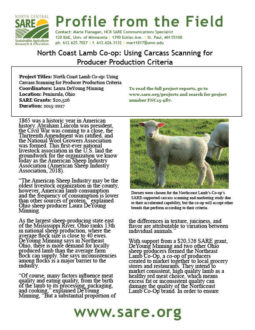In 1865, the National Wool Growers Association was formed. This first-ever national livestock association in the U.S. laid the groundwork for the organization we know today as the American Sheep Industry Association (American Sheep Industry Association, 2018). “The American Sheep Industry may be the oldest livestock organization in the county, however, American lamb consumption and the frequency of consumption is lower than other sources of protein,” explained Ohio sheep producer Laura DeYoung Minning.
As the largest sheep-producing state east of the Mississippi River, Ohio ranks 13th in national sheep production, where the average flock size is close to 40 ewes. DeYoung Minning says in Northeast Ohio, there is more demand for locally produced lamb than the average farm flock can supply. She says inconsistencies among flocks is a major barrier to the industry. “Of course, many factors influence meat quality and eating quality, from the birth of the lamb to its processing, packaging, and cooking,” explained DeYoung Minning, “But a substantial proportion of the differences in texture, juiciness, and flavor are attributable to variation between individual animals.”
With support from a $20,526 SARE grant, DeYoung Minning and two other Ohio sheep producers formed the Northeast Lamb Co-Op, a co-op of producers created to market together to local grocery stores and restaurants. They intend to market consistent, high quality lamb as a healthy red meat choice, which means excess fat or inconsistent quality can damage the quality of the Northcoast Lamb Co-Op brand. In order to ensure quality and consistency, the co-op determined that they would require carcass centralized ultrasound processing scanning for all co-op members. quality and consistency, the co-op determined that they would require carcass centralized ultrasound processing scanning for all co-op members.
The three founding member producers each had Dorset flocks with similar production practices including riparian setbacks, rotational grazing, and nutrient management. Each used carcass scanning to evaluate their flocks. They determined that lambs from these flocks were even enough to ensure consistent quality to market lamb using the co-op label. Dorsets were originally chosen by the co-op members, and they met the co-op’s carcass loin eye criterion (an average 2.5 square inch loin between the 12th and 13th rib is used as criteria for acceptance to market lamb in the co-op). The three producers in the co-op want to expand and include other regional producers using the scanning methodology; they found it to be far more reliable than using weight and visual observations, which DeYoung Minning says can result in smaller loin eyes and too much back fat.
“The Co-op wants to work with any urban or rural farmer whose purpose is, to not only distribute and market lamb at a profit, but to produce the required high quality, consistent lamb demanded by a more discriminating marketplace,” said DeYoung Minning. “The Co-op will continue to assist members in identifying new strategies and methods to improve the quality of their flocks to help meet the rising demand for high value, quality lamb.”
View Minning's presentation on this project, from the 2018 Farmer's Forum, through NCR-SARE's Youtube video. Visit www.youtube.com/NCRSAREvideo for this and other videos.
